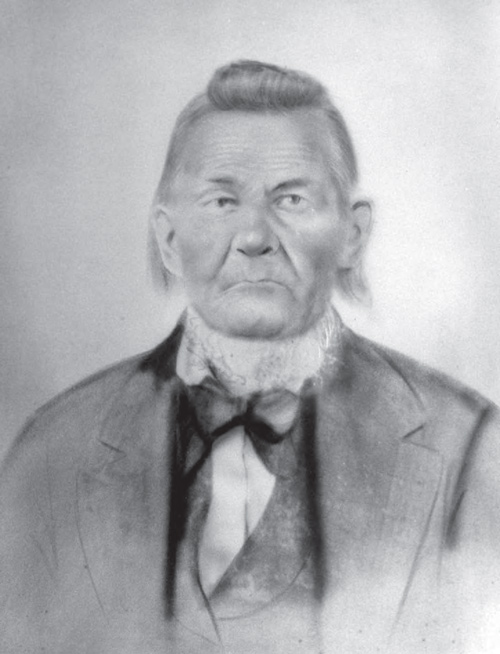A Popular Sergeant
Patrick Gass
Courtesy Eugene Gass Painter.[1]See J. I. Merritt, “A ‘New’ Portrait of Patrick Gass,” We Proceeded On, February 2001, lewisandclark.org/wpo/pdf/vol27no1.pdf#page=28.
Patrick Gass must have been a likeable fellow. On 22 August 1804, two days of Sgt. Charles Floyd died and at present Elk Point, South Dakota, the captains held a nominating vote for his replacement. Certainly all the twenty-five enlisted men of the permanent party voted, and possibly the captains included the return party’s six men. Gass received nineteen nods, a majority of either 76% or 61%. A few votes, quantity unrecorded, went to George Gibson and William Bratton. Four days later, Gass was officially promoted to the rank of sergeant. Lewis wrote:
the Commanding officers are still further confirmed in the high opinion they had previously formed of the capacity, deligence and integrety of Sergt. Gass, from the wish expressed by a large majority of his comrades for his appointment as Sergeant.
Meriwether Lewis must also have liked the Pennsylvania-born Irishman. A year later,[2]On 2 August 1805. when Gass erred in a way likely to bring a display of Lewis’s quick temper, the captain wrote indulgently, even cheerfully,
Sergt. Gass lost my tommahawk in the thick brush and we were unable to find it, I regret the loss of this usefull implement, however accedents will happen in the best families, and I consoled myself with the recollection that it was not the only one we had with us.
Army Career
Gass, a career soldier since 1799, had wanted to join the expedition when Lewis arrived in his post, Fort Kaskaskia in “the Illinois.” His own commander, Capt. Russell Bissell, turned him down, so he took his request directly to Lewis, who talked Bissell into it. Gary Moulton speculates that Bissell may not have wanted to lose a skilled carpenter like Gass[3]Gary E. Moulton, ed., The Journals of the Lewis and Clark Expedition, 13 vols. (Lincoln: University of Nebraska Press, 1983-2001), 10:xiv.—which made him even more valuable to a group that faced building two or three winter cantonments.
He had previously served in the Army Rangers after enlisting in 1799—a guerrilla fighting unit that exists to this day. British Gen. John Burgoyne, who faced the first Rangers during the Revolutionary War, described them as “the most famous corps of the Continental Army, all of them crack shots.”[4]Website of the U.S. Army Rangers, www.ranger.org/ accessed 5-12-06.
The private had enlisted at age 28, and became the expedition’s third-oldest army member, after John Shields (b. 1769) and Captain Clark (b. 1770). Possibly Gass’s carpenter training came from a pre-enlistment apprenticeship.
Journalist
He did not learn to read and write until he was a grown man, but he did keep an expedition journal—as was required of all sergeants. Unless he later reconstructed the portion predating August 1804, Gass had been keeping that journal since the expedition started out on 14 May 1804. His was the first of any to see print, in 1807, but sadly for those who savor the other journalists’ rough-hewn orthography and grammar, the text was rewritten into formal prose. Perhaps because it reminded Lewis that he was failing to produce his own book, the captain raised a public fuss. He exchanged and published angry letters to the book’s publisher and likely editor of his manuscript, David McKeehan of Pittsburgh. Lewis’s argument that Gass’s book was unauthorized led McKeehan to charge Lewis with demanding to be “him who commands and dispenses favors.” McKeehan’s fury led him so far as to suggest that perhaps Pierre Cruzatte‘s shooting of Lewis was no accident.[5]Moulton, 10:xvi.
Six other publishers soon picked up the book, with Mathew Carey of Philadelphia introducing several illustrations that Moulton calls “quaint and highly imaginative scenes from the expedition.”[6]Moulton, 10:xvii. As was usual at the time, the publisher rather than the author profited from the book’s sales. Gass’s journal, for all its shortcomings, was the only authentic account of the expedition that was in print until Nicholas Biddle‘s paraphrase of the captains’ journals came out in 1814.
Carpenter
Gass no doubt was carpenter-in-charge for building Camp Wood, Fort Mandan, and Fort Clatsop. In fact, only in his journal—with some added information in John Ordway‘s—do we read the dimensions and layout of Fort Mandan. At the Great Falls of the Missouri, Lewis assigned carpenter Gass and blacksmith Shields to craft and fit the interior wooden braces of the iron boat, once they located suitable lumber. In October 1805, on the Clearwater River in Idaho, Gass and three others repaired a canoe that split open and doused the stock of trade goods. While the “merchandize” dried out on the 10th, they went to work, and “at 1 oClock She was finished Stronger than ever” (Clark).
When faced with their decision at the mouth of the Marias River, about which fork was the true Missouri, the captains first sent Gass and two men up the Missouri while Ordway and two others went up the Marias. Gass marched only 6.5 miles, Ordway 10, and neither found the expected large, single waterfall. These forays changing no one’s mind, so the captains made their own separate and lengthier treks.
Despite his duties as a non-commissioned officer, Gass sometimes joined the expedition’s hunting trips. He experienced no outstanding adventures on the journey, and no major injuries or illnesses, but slipping in a canoe and falling back onto the gunwale invalided him off the Jefferson River and into Lewis’s advance party that located the Lemhi Shoshones in August 1805.
After the Expedition
Gass stayed in the army after the expedition, and served in the War of 1812. At one point during the war he worked under Daniel Boone in the construction of a small temporary fort on the Mississippi known as Fort Independence, or “Cap-au-Gris.” He lost one eye in an accident and was honorably discharged. For many years thereafter he worked at many jobs, first in Ohio and then in future West Virginia. Still a bachelor at age sixty, he accepted a construction job from a man named Hamilton, at Wellsburg, and soon eloped with twenty-year-old Maria, Hamilton’s only daughter. The couple immediately settled in a rented log cabin and began farming. They had seven children, six of whom survived to adulthood. When their last child was a baby, Maria died during a measles epidemic at age thirty-six. Patrick was then seventy-five, but he raised his other children alone.[7]Larry E. Morris, The Fate of the Corps: What Became of the Lewis and Clark Explorers After the Expedition (New Haven: Yale University Press, 2004), 182-83. Jackson, Letters, 1:144; 2:647. Until nearly the end of his life, he walked four miles into Wellsburg to pick up his mail. The end came when he was ninety-nine years old, the expedition’s last survivor.[8]Morris says Gass was “fourteen months short of one hundred.” p. 184.
Notes
| ↑1 | See J. I. Merritt, “A ‘New’ Portrait of Patrick Gass,” We Proceeded On, February 2001, lewisandclark.org/wpo/pdf/vol27no1.pdf#page=28. |
|---|---|
| ↑2 | On 2 August 1805. |
| ↑3 | Gary E. Moulton, ed., The Journals of the Lewis and Clark Expedition, 13 vols. (Lincoln: University of Nebraska Press, 1983-2001), 10:xiv. |
| ↑4 | Website of the U.S. Army Rangers, www.ranger.org/ accessed 5-12-06. |
| ↑5 | Moulton, 10:xvi. |
| ↑6 | Moulton, 10:xvii. |
| ↑7 | Larry E. Morris, The Fate of the Corps: What Became of the Lewis and Clark Explorers After the Expedition (New Haven: Yale University Press, 2004), 182-83. Jackson, Letters, 1:144; 2:647. |
| ↑8 | Morris says Gass was “fourteen months short of one hundred.” p. 184. |
Experience the Lewis and Clark Trail
The Lewis and Clark Trail Experience—our sister site at lewisandclark.travel—connects the world to people and places on the Lewis and Clark Trail.
Discover More
- The Lewis and Clark Expedition: Day by Day by Gary E. Moulton (University of Nebraska Press, 2018). The story in prose, 14 May 1804–23 September 1806.
- The Lewis and Clark Journals: An American Epic of Discovery (abridged) by Gary E. Moulton (University of Nebraska Press, 2003). Selected journal excerpts, 14 May 1804–23 September 1806.
- The Lewis and Clark Journals. by Gary E. Moulton (University of Nebraska Press, 1983–2001). The complete story in 13 volumes.



